Menus
- Fast as an arrow and better than ever before
- Handy and nicely balanced
- Crossplane engine became quieter
- R1M always offers a little more grip
- Conclusion
Motorcycle fair in Milan
EICMA 2019
Presented by

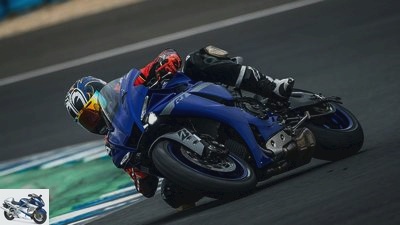
Yamaha / Jonathan Godin
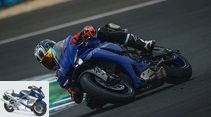
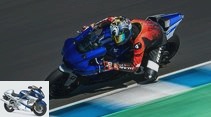
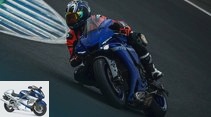
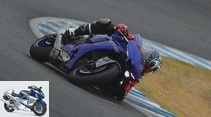
13 photos
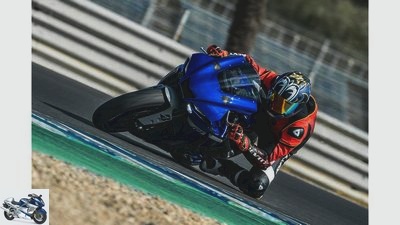
Yamaha / Jonathan Godin
1/13
The new model has been cleverly improved in detail.

Yamaha / Jonathan Godin
2/13
For example, R1 pilots can now enjoy a chassis that is very responsive.
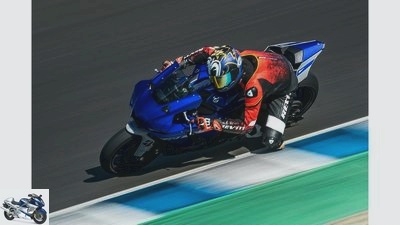
Yamaha / Jonathan Godin
3/13
The R1 does not behave as bomb-proof as in an inclined position when the anchor is thrown brutally, because it lurches slightly with the stern – but always friendly and easy to control.

Yamaha / Jonathan Godin
4/13
Folded tightly on the machine, the standard higher screen offers useful wind protection – nothing tugs, twitches or wobbles at high speed.
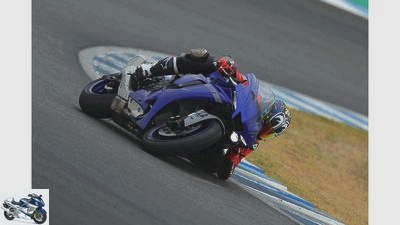
Yamaha / Jonathan Godin
5/13
the YZF-R1 still sounds great, but a bit quieter.
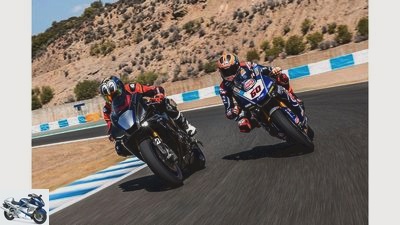
Yamaha / Jonathan Godin
6/13
That leaves the YZF-R1M.

Yamaha / Jonathan Godin
7/13
It differs from the standard model by its carbon cladding and the latest generation of semi-active Ohlins chassis.
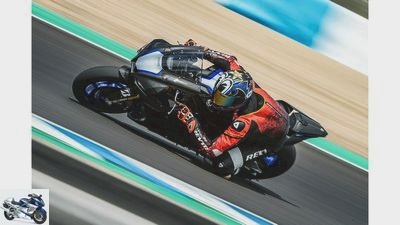
Yamaha / Jonathan Godin
8/13
We also ride the M in Jerez with Bridgestone V02 slicks in size 200 on the rear wheel.
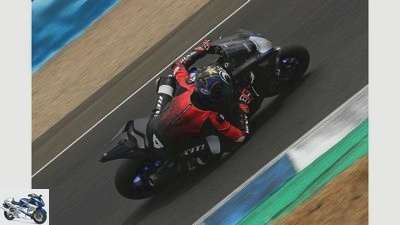
Yamaha / Jonathan Godin
9/13
The big difference to the standard model is that the R1 M builds up more grip in every situation – a lot more!
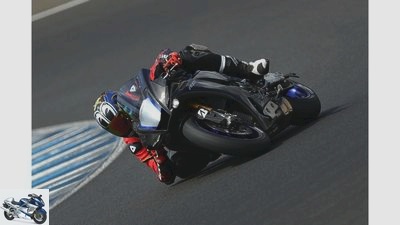
Yamaha / Jonathan Godin
10/13
The slicks and the chassis can handle full throttle and a much harder pace earlier.

Yamaha / Jonathan Godin
11/13
During the press presentation in Jerez, the semi-active Track 1 mode works very well without any further fine-tuning.
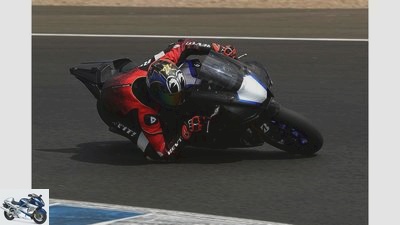
Yamaha / Jonathan Godin
12/13
The front wheel feel is even better than with the standard R1, and even when braking hard, the R1 M stays quietly on track.
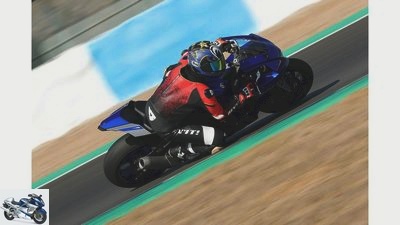
Yamaha / Jonathan Godin
13/13
Both the YZF-R1 and the YZF-R1 M have reached a very high level of maturity with the new generation of models.
Yamaha YFZ-R1 and R1 M
Fast as an arrow and better than ever before
Yamaha is early on with the press presentation of the 2020 Superbike class. Six turns are available in Jerez to test the two grenades YZF-R1 and YZF-R1 M. We will not be asked any longer!
The Jerez racetrack was only repaved last year and, with very few exceptions, the surface is in excellent condition. Only at the apex of a long left turn, which is at the beginning of the last third of the slope, are there bumps. However, the tiles Yamaha YZF-R1 mastered this tricky passage with ease. This is followed by a few right-hand turns, which you can take in an arc with a little swing and precision – with the precise R1, the maneuver succeeds almost immediately.
Handy and nicely balanced
The new model has been cleverly improved in detail. For example, R1 pilots can now enjoy a chassis that is very responsive. The Kayaba fork and shock absorber have been revised and retuned. In general, the handy R1 feels nicely balanced. In particular, the feeling for the front and the confidence in the grip of the Bridgestone R11 tires (the R1 comes with RS11 tires as standard) is great. The Yamaha drives brilliantly over the front wheel, which gives the rider a great deal of freedom of choice when choosing a line – regardless of whether you are entering or exiting a curve. In addition, the fork dampens hard when braking hard and has plenty of reserves ready. After the first turn, we give the shock absorber two clicks more compression, which makes the rear quieter in the braking zone. The R1 does not behave as bomb-proof as it does in an inclined position when it comes to a brutal anchor throw, because it lurches slightly with the stern – but it is always friendly and easy to control. Incidentally, the brakes with the new pads are more snappy and can be dosed more sensitively than on the previous model. The ABS now also has two modes available, one normal and one with a curve function. During the first rollout here in Jerez, the two modes hardly differ from one another in terms of their control behavior.
Yamaha / Jonathan Godin
Yamaha also lend a hand with the aerodynamics, because the 2020 YZF-R1 is not only appealing with its discreetly pepped up look (redesigned front and side panels). Above all, the machine has become more streamlined, which should even have a positive effect on the top speed. Folded tightly on the machine, the standard higher screen also offers useful wind protection – nothing tugs, twitches or wobbles at high speed.
Crossplane engine became quieter
As far as the performance of the engine is concerned, the well-known performance figures of 200 hp at 13,500 rpm remain. Nevertheless, a lot has happened inside the crossplane inline four-cylinder: the cylinder head, the injection and cooling system and the oil circuit have been optimized just like the intake system. The engine has enough power in spite of Euro 5 coordination, its high revving and the deep vibes of the bigbang drive are still addicting! Speaking of sound – the YZF-R1 still sounds great, but a bit quieter. Now that you can’t even drive with the original exhaust on many racetracks because of the volume, this is a step in the right direction.
Finally, new and improved functions strengthen the electronics package of the YZF-R1. The brake control system (BC) with cornering function has already been mentioned, and the technicians have also adjusted the launch control (racing start aid) differently. Furthermore, it is now possible to set the engine braking torque in three stages and thus adapt it to the driver’s personal preferences. On the Jerez race track, stage two works extremely well with a slightly reduced braking torque, since many corner entrances are fast. It is also noticeable that the R1 with the new mechanical throttle accepts the same as squeaky clean: direct, but not rough. The traction control (ten levels) regulates the slip on the rear wheel cleanly and almost imperceptibly. The wheelie control (three levels) also does its job well, because it gently sets the front wheel down on the ground. At least at level one, it should allow slightly longer wheelies.
R1M always offers a little more grip
All that remains is the YZF-R1M, to which all the technical changes already mentioned apply in exactly the same way. It differs from the standard model in its carbon cladding and the latest generation of semi-active Ohlins chassis, which has been specially designed for the YZF-R1 M. We also ride the M in Jerez with Bridgestone V02 slicks in size 200 on the rear wheel. The big difference to the standard model is that the R1 M builds up more grip in every situation – a lot more! It literally sticks to the road and lies extremely well in the inclined position.
Yamaha / Jonathan Godin
The slicks and the chassis can handle full throttle and a much harder pace earlier. It feels like you get there faster at every curve with at least 20 km / h and out again faster than with the standard R1. Of course, the semi-active chassis of the M version can be set and adapted in all possible directions according to the driver’s preferences, the nature and properties of the tires and the route. During the press presentation in Jerez, the semi-active Track 1 mode works very well without any further fine-tuning. The front wheel feel is even better than with the standard R1, and even when braking hard, the R1 M stays smoothly on track.
Conclusion
Both the YZF-R1 and the YZF-R1 M have reached a very high level of maturity with the new generation of models. Both are lightning-fast motorcycles that are now even better than ever.
Related articles
-
fact Review Yamaha FZ6 S2 New Fazer with more power The popular Yamaha FZ6 has finally been given a major makeover. And starts the new season with full…
-
Artist Comparative test of evergreens against current top models BMW R 1100 RS versus R 1100 S. Kawasaki ZZ-R 1100 versus ZX-12R Yamaha YZF 1000…
-
fact 27 pictures fact 1/27 After six years, Yamaha has completely redesigned the sporty top model. The new YZF-R1 now has a completely …
-
Yamaha MT-09 and MV Agusta Brutale 800 in comparison test
bilski-fotografie.de 16 photos bilski-fotografie.de 1/16 MV Agusta Brutale 800 and Yamaha MT-09. www.bilski-fotografie.de 2/16 Typical MV: Hybrid frame…
-
Comparison test BMW S 1000 RR, Ducati 1299 Panigale S and Yamaha YZF-R1
fact 46 photos fact 1/46 Yamaha YZF-R1. fact 2/46 BMW S 1000 RR. fact 3/46 The swing arm takes the wheel axle very far back – good for driving stability….
-
Honda Hornet 600, Kawasaki Z 750, Suzuki GSR 600, Yamaha FZ6
Jahn Honda Hornet 600, Kawasaki Z 750, Suzuki GSR 600, Yamaha FZ6 Comparison test all-rounder Do you do a job in a high position? as the darling of the…
-
Youngtimer test: Yamaha FJ 1200
Archive Youngtimer-Test: Yamaha FJ 1200 Intercity-Express Fast and comfortable from A to B – with the ICE of the train. Or on two wheels and with one …
-
Yamaha YZF-R6 (2017) in the driving report
Yamaha 30 pictures 1/30 The new Yamaha YZF-R6 in the driving report. 2/30 The new Yamaha YZF-R6 in the driving report. 3/30 The new Yamaha YZF-R6 in the driving report. 4/30 …
-
Driving report Yamaha MT-03: sensible, fun-loving, grown up
15th photos 1/15 The Yamaha MT-03 has been thoroughly redesigned for the model year. 2/15 A lot has also changed visually. 3/15 One of the new features…
-
Top test: Yamaha XT 1200 Z Super Tenere
Bilski 23 photos Yamaha 1/23 The wheel speed sensors for ABS and traction control receive their signals from radially mounted rings. Yamaha 2/23 In the…